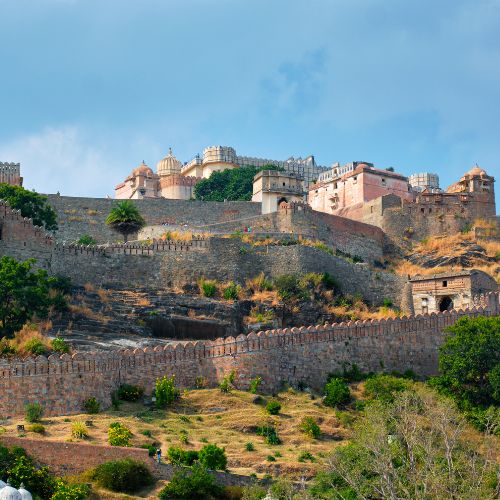6 World Heritage Sites to visit in Pakistan
Pakistan is home to several remarkable UNESCO World Heritage Sites
- Fort and Shalamar Gardens in Lahore, Punjab
- Rohtas Fort, Punjab
- Taxila, Punjab
- Archaeological Ruins at Moenjodaro, Sindn
- Historical Monuments at Makli, Thatta City of Sindn
- Buddhist Ruins of Takht-i-Bahi and Neighbouring City Remains at Sahr-i-Bahlol, Khyber-Pakhtunkhwa
Fort and Shalamar Gardens in Lahore
Lahore Fort and Shalamar (or Shalimar) Gardens in Lahore are two masterpieces from the time of the brilliant Mughal civilization, which reached its height during the reign of the Emperor Shah Jahan. The fort contains marble palaces and mosques decorated with mosaics and gilt. The gardens, built near the city of Lahore on three terraces with lodges, waterfalls and large ornamental ponds, is unequalled.

The Lahore Fort is a citadel in the city of Lahore. The fortress is located at the northern end of walled city Lahore, and spreads over an area greater than 20 hectares.
The fort contains 21 notable monuments, some of which date to the era of Emperor Akbar. The Lahore Fort is notable for having been almost entirely rebuilt in the 17th century, when the Mughal Empire was at the height of its splendour and opulence.
The fort’s Alamgiri gate is part of an ensemble of buildings, which along with the Badshahi Mosque, Roshnai Gate, and Samadhi of Ranjit Singh, form a quadrangle around the Hazuri Bagh. The Minar-e-Pakistan and Iqbal Park are adjacent to the northern boundary of the fort.

The Shalamar Gardens are a Mughal garden complex located in Lahore, next to the Grand Trunk Road, about 5 kilometres east of the Delhi Gate of the Walled City of Lahore.
The gardens, now one of Pakistan’s most popular tourist destinations, date from the period when the Mughal Empire was at its artistic and aesthetic zenith. In 1981, Shalimar Gardens was included as a UNESCO World Heritage Site along with the Lahore Fort.
Rohtas Fort

Rohtas Fort is a 16th-century fortress located near the city of Dina in Jhelum district of the Punjab province of Pakistan. The fort remains remarkably intact and was declared a UNESCO World Heritage Site in 1997.
Following his defeat of the Mughal emperor Humayun in 1541, Sher Shah Suri built a strong fortified complex at Rohtas, a strategic site in the north of what is now Pakistan. It was never taken by storm and has survived intact to the present day.
The main fortifications consist of the massive walls, which extend for more than 4 km; they are lined with bastions and pierced by monumental gateways. Rohtas Fort, also called Qila Rohtas, is an exceptional example of early Muslim military architecture in Central and South Asia.
Taxila

Taxila is a city in Punjab, located 32 km (20 mi) north-west of the Pakistani capital Islamabad. Taxila was designated a UNESCO World Heritage Site in 1980 in particular for the ruins of the four settlement sites which “reveal the pattern of urban evolution on the Indian subcontinent through more than five centuries”
From the ancient Neolithic tumulus of Saraikala to the ramparts of Sirkap (2nd century B.C.) and the city of Sirsukh (1st century A.D.), Taxila illustrates the different stages in the development of a city on the Indus that was alternately influenced by Persia, Greece and Central Asia and which, from the 5th century B.C. to the 2nd century A.D., was an important Buddhist centre of learning.
Archaeological Ruins at Moenjo-daro

Mohenjo-daro is an archaeological site in the province of Sindh, Pakistan. Built around 2500 BCE, it was the largest settlement of the ancient Indus Valley Civilisation, and one of the world’s earliest major cities, contemporaneous with the civilizations of ancient Egypt, Mesopotamia, Minoan Crete, and Norte Chico.
Mohenjo-daro was abandoned in the 19th century BCE, and the site was not rediscovered until the 1920s. The ruins of the huge city of Moenjodaro ; built entirely of unbaked brick in the 3rd millennium B.C.; lie in the Indus valley.
The acropolis, set on high embankments, the ramparts, and the lower town, which is laid out according to strict rules, provide evidence of an early system of town planning.
The city’s original name is unknown. Mohenjo-daro, the modern name for the site, has been interpreted as “Mound of the Dead Men” in Sindhi
Historical Monuments at Makli, Thatta

Makli Necropolis is one of the largest funerary sites in the world, spread over an area of 10 kilometres near the city of Thatta, in the Pakistani province of Sindh. The site houses approximately 500,000 to 1 million tombs built over the course of a 400-year period.
The capital of three successive dynasties and later ruled by the Mughal emperors of Delhi, Thatta was constantly embellished from the 14th to the 18th century. The remains of the city and its necropolis provide a unique view of civilization in Sind.
Buddhist Ruins of Takht-i-Bahi and Neighbouring City Remains at Sahr-i-Bahlol

Takht-i-Bahi is an Indo-Parthian archaeological site of an ancient Buddhist monastery in Mardan, Khyber-Pakhtunkhwa, Pakistan.
The Buddhist monastic complex of Takht-i-Bahi (Throne of Origins) was founded in the early 1st century. Owing to its location on the crest of a high hill, it escaped successive invasions and is still exceptionally well preserved. Nearby are the ruins of Sahr-i-Bahlol, a small fortified city dating from the same period.
The ruins are located about 15 kilometres (9.3 mi) from Mardan in Pakistan’s Khyber-Pakhtunkhwa Province, also sit near a modern village known by the same name.



